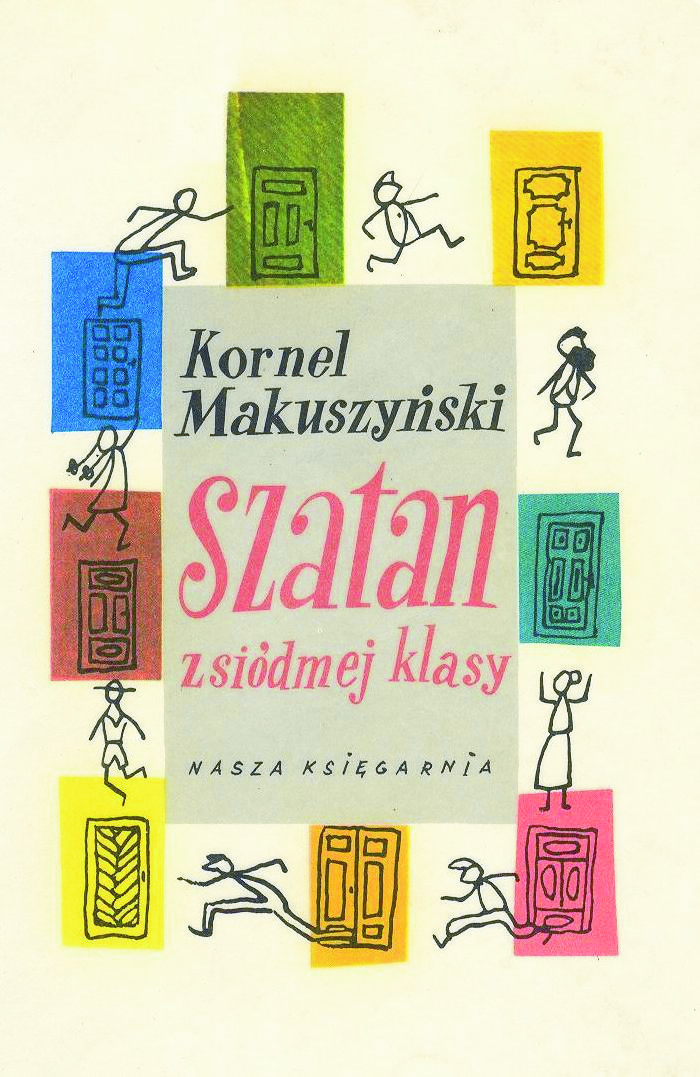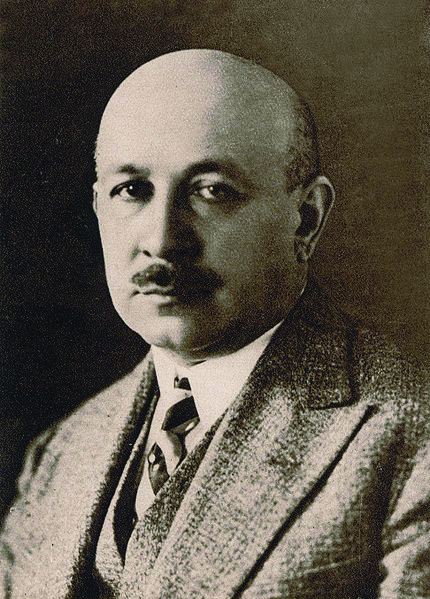Title of the work
Country of the First Edition
Country/countries of popularity
Original Language
First Edition Date
First Edition Details
Kornel Makuszyński, Szatan z siódmej klasy. Warszawa: nakład Gebethnera i Wolffa, 1937, [number of pages unknown].
ISBN
Genre
Detective and mystery fiction
Novels
School story*
Teen fiction*
Target Audience
Young adults
Cover

Courtesy of Nasza Księgarnia.
Author of the Entry:
Summary: Joanna Kłos, University of Warsaw, joanna.klos@student.uw.edu.pl
Paweł Siechowicz, University of Warsaw, pawelsiechowicz@wp.pl
Analysis: Karolina Anna Kulpa, University of Warsaw, k.kulpa@al.uw.edu.pl
Peer-reviewer of the Entry:
Katarzyna Marciniak, University of Warsaw, kamar@al.uw.edu.pl
Elżbieta Olechowska, University of Warsaw, elzbieta.olechowska@gmail.com

Kornel Makuszyński, portrait retrieved from Wikimedia Commons (accessed: June 27, 2018).
Kornel Makuszyński
, 1884 - 1953
(Author)
Poet, writer, publicist, theatre critic and literary director of Polish theatres in Lvov and Kiev. The most famous of his books for children is a comic book 120 Przygód Koziołka Matołka [120 Adventures of Matołek the Kid Goat], 1933, with illustrations by Marian Walentynowicz. His other bestsellers and now classics of Polish literature for children include O dwóch takich, co ukradli księżyc [The Two Who Stole the Moon], 1928; Przyjaciel wesołego diabła [Merry Devil’s Friend], 1930; Awantura o Basię [The Row over Basia], 1936; Szatan z siódmej klasy [Demon in 7th Grade], 1937, and Szaleństwa panny Ewy [Miss Eva’s Follies], ed. 1957 (written in 1940s, the manuscript survived the 1944 Warsaw Uprising), all of which were made into films after the author’s death. He debuted as a young poet with the assistance of the famous modernist poet Jan Kasprowicz but soon became widely known as a talented humorist (e.g. Awantury arabskie [Arabian Adventures], 1913), publicist and theatre critic. He is also the author of novels portraying the life of artistic bohemia Perły i wieprze [Pearls and Pigs], 1915, and Po mlecznej drodze [On the Milky Way], 1917. His memoires of childhood and youth were published under the title Bezgrzeszne lata [Sinless Years], 1925.
An enthusiastic skier and mountain-lover ended his life in the Tatras’ resort Zakopane, where the museum presenting his life and works is now placed. The understanding of the psychology of young readers, ability to create attractive plots, an amusing and lyrical style, chatty volubility, optimism, upright characters and the faith in human kindness represented in his books allow them to have a stable place in the canon of Polish children and youth literature.
Sources:
Kaczanowska, Jagna, Kornel Makuszyński – ze słońcem w herbie. Zwierciadło.pl (accessed: June 27, 2018).
"Makuszyński Kornel", in Jan Wojnowski, ed., Literatura polska XX wieku. Przewodnik encyklopedyczny, Warszawa: Wydawnictwo Naukowe PWN, 2000, 406.
Bio prepared by Paweł Siechowicz, University of Warsaw, pawelsiechowicz@wp.pl

Zbigniew Piotrowski (Illustrator)
Adaptations
Film: dir. Konrad Tom, As-Film, 1939 (not finished).
Film: dir. Maria Kaniewska, Zespół Filmowy “Start”, 1960.
Film: dir. Kazimierz Tarnas, 2006.
Series (7 parts), dir. Kazimierz Tarnas, 2006.
Translation
French: Le satan de la classe de première, trans. Yolande Bernard, Paris: Acad. européenne du livre, 1992.
Hebrew: Ha-šed mi-kitah 7, trans. Sbiy Yašiyb, Tel-ʾAbiyb: ʿAmiyhay, 1964.
Slovak: Fiškus zo VII. triedy, trans. Peter Čačko, Bratislava: Mladé Letá, 1979.
Summary
Based on: Katarzyna Marciniak, Elżbieta Olechowska, Joanna Kłos, Michał Kucharski (eds.), Polish Literature for Children & Young Adults Inspired by Classical Antiquity: A Catalogue, Faculty of “Artes Liberales”, Warsaw: University of Warsaw, 2013, 444 pp.
Professor Gąsowski is shocked when he discovers that his students have known for a long time his scheme for questioning them during class. It turns out that it was deciphered by Adam Cisowski – a brilliant student with a special gift for solving puzzles. Moreover, Adam accepts the challenge issued by the professor – he will try to guess whom the teacher will select to answer his question during the next class, according to a new scheme. To the professor’s surprise, Adam succeeds. Adam also unravels two other mysteries at school – he finds out who stole his colleague’s fountain pen and why a large sum of money is missing from the accounts of the school store.
Delighted with Adam’s shrewdness Professor Gąsowski asks him for help – at his brother’s estate several doors have been stolen in mysterious circumstances and then found in the vicinity, with paint scraped away. Adam gladly agrees to spend holidays there and try to solve the case, especially that he is impressed by the beauty of the professor’s niece, Wanda. Old diaries stored at the attic of the house, an inscription left on the door, as well as other clues hidden at the estate lead Adam to a solution of the mystery and to a treasure left there years ago by a Napoleonic soldier. Adam’s detective talents help him not only to find the treasure but also to catch the criminals who wanted to steal it from the family.
Analysis
Kornel Makuszyński has written many popular novels for children and young adults, but Szatan z siódmej klasy is one of a kind. This detective novel for youth with action-packed plot includes numerous riddles to solve and a treasure to find, has plenty of humour, which could make laugh also adult readers. The author saved for posterity a small, but very interesting part of daily life in the vicinity of Wilno, at that time a Polish city, two years before WW2 began. He introduces the reader to the Polish school reality, where, in a male gymnasium, a young Adam Cisowski helps his colleagues solve many problems, including getting to the truth in case of a boy suspected of stealing class money. At the time of the publication, Latin was a compulsory subject in Polish secondary schools, so it is safe to assume that students had knowledge of ancient times. Classical themes appear in the novel constantly, as there are numerous references to Graeco-Roman mythology and history, e.g. Clio called “the staid Muse of history”; the stillness of the boat floating on the lake compared to that of Charon’s boat, or the complicated story of a mysterious letter found by Adam quipped with "Habent sua fata epistolae!" – a variation of Terentianus Maurus’ quote "Habent sua fata libelli"; when a boy is asked to deliver the letter to a man living nearby, he is called Mercury; in the final riddle that leads to the discovery of the treasure, the stork’s nest is described as the house whose owner has never eaten from a flat plate during a feast – an indirect reference to Aesop’s fable about the fox and the stork. On the other hand, one of the characters, the history teacher Professor Gąsowski, tells his students which ancient figures have his sympathy and which do not. Gąsowski adores Pericles, but Julius Caesar, Alcibiades and Hannibal are not his favorites. He also, like his brother, the math teacher, often quotes fake Latin expressions, like “Fugas chrustas” (chapter one) or real ones like “Periculum in mora” (chapter eleven).
Possibly, Makuszyński’s book inspired another Polish author, Zbigniew Nienacki, to create twenty years later a series of popular detective novels Pan Samochodzik [Mister Little Car] about solving the mysteries and finding historical treasures, often with the help of young people.
According to Regulation of Polish Ministry of National Education of December 23, 2008 (and then to Regulation of August 23, 2012) Szatan z siódmej klasy was on the list of primary school optional books for grades four to six from which the teacher could choose four titles a year. Since the new regulation of February 14, 2017, the novel has been removed from that list, but the teacher can still decide to include it as additional reading.
Further Reading
Biernat, Ewa, Twórczość baśniowa Kornela Makuszyńskiego, Kraków: Oficyna Wydawnicza „Impuls”, 2001.
Kowalczykówna, Joanna, Z badań nad warsztatem literackim Kornela Makuszyńskiego jako autora powieści dla młodzieży, Piotrków Trybunalski: Wydawnictwo Filii Kieleckiej WSP, 1997.
Piasecka, Dorota, Proza Kornela Makuszyńskiego dla młodego odbiorcy. Zarys problematyki, Warszawa–Wrocław: Państwowe Wydawnictwo Naukowe, 1984.
Addenda
Entry prepared on edition: Kornel Makuszyński, Szatan z siódmej klasy. Warszawa: Nasza Księgarnia, 1989, 271 pp.


